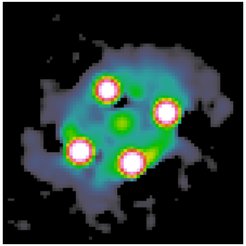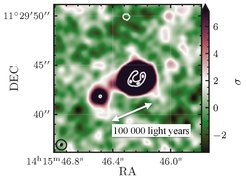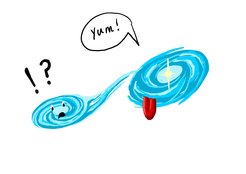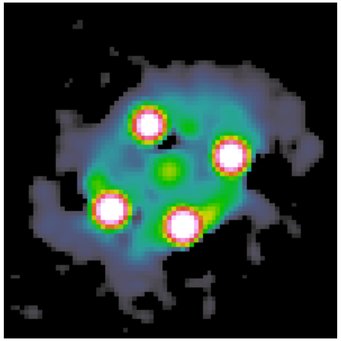Astronomers witness a monstrous galaxy consuming its neighbour
Observing a supermassive black hole in the distant Universe, MPA astronomers have discovered that it is in the process of stripping gas from a neighbouring galaxy. The gas is being very quickly turned into stars in the black hole’s host galaxy and is allowing the black hole to grow very quickly. This agrees with theoretical predictions that massive galaxies and black holes form with help from mergers with smaller galaxies and bursts of star formation.

A quasar is the extremely luminous nucleus of a galaxy, produced by a supermassive black hole that is rapidly consuming matter. Quasars are thought to play an important role in the formation of massive galaxies in the early universe. But we don’t yet know in detail how their supermassive black holes are formed, evolve and activate. Nor do we know how they interact with their host galaxies.
As the host galaxies of quasars are typically very small and much fainter than the quasar, it is a challenge to observe them in detail. The well-known ‘Cloverleaf’ is an example of a gravitational lens system, whereby a quasar whose light was emitted 11 billion years ago is magnified by the gravitational field of an intervening galaxy. In optical light, we see a mirage of four images (that was dubbed the Cloverleaf) of the accreting supermassive black hole. In microwaves, we see its host galaxy, which is otherwise hidden. This host galaxy is forming an incredible 1000 stars per year. Gravitational lensing magnifies the Cloverleaf galaxy so that we can examine it in detail.

When looking through archive data from the Atacama Large sub-Millimetre Array (ALMA) to catalogue dust and carbon monoxide gas, we found a companion galaxy that was not previously known about. The data showed that the companion is connected to the Cloverleaf by an intergalactic bridge of gas — meaning that the Cloverleaf is in the process of consuming it! For the first time, we have thus directly observed a galaxy stripping its neighbour of star-forming gas in the very distant Universe.
However, we also discovered evidence that a wind is driving gas out of its host galaxy, powered by the quasar or the extreme star formation. This means, that at the same time as consuming its neighbour, some of the gas is being driven out, stripping the galaxy of raw material for star formation. These findings agree with theoretical predictions that massive galaxies form via mergers of smaller galaxies, with black holes playing a role to suppress the formation of new stars.

Over the next hundred million years, we expect the Cloverleaf galaxy to completely consume its companion, then quickly run out of gas. It would then become a very massive, ‘dead’ galaxy, like the ones we see in the current Universe. It is only because of the very sensitive ALMA data and because the galaxy is magnified by gravitational lensing that we are able to see this happening in the early Universe.














